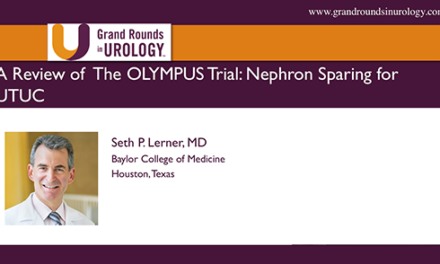Contemporary Management of Upper Tract Urothelial Carcinoma
Robert Abouassaly, MD, presented “Contemporary Management of Upper Tract Urothelial Carcinoma” at the 26th Annual Perspectives in Urology: Point-Counterpoint, November 11, 2017 in Scottsdale, AZ
How to cite: Abouassaly, Robert “Contemporary Management of Upper Tract Urothelial Carcinoma” November 11, 2017. Accessed Jun 2025. https://grandroundsinurology.com/Upper-Tract-Urothelial-Carcinoma/
Summary:
Robert Aboussaly, MD, explains up-to-date approaches to treating upper tract urothelial carcinoma, including risk-stratification in diagnosis, nephroureterectomy, neoadjuvant chemotherapy, and postoperative intravesical chemotherapy.
Contemporary Management of Upper Tract Urothelial Carcinoma
Transcript:
So I’ll be talking about upper tract urothelial carcinomas, and I do have a couple of audience response questions. So, what is a common alteration, genetic alteration associated with low-grade upper tract urothelial carcinoma, P53, retinoblastoma, FGFR3, or genetic instability?
Okay. P53 is the answer. We’ll see if that is the case. Which of the following statements are true regarding upper tract urothelial carcinoma? In the largest published series, lymph node dissections were performed in the majority of patients undergoing nephroureterectomy, lymph node positivity as associated with tumor grade, patients with lymph node involvement have the 50% five-year survival and lymph node dissection templates are well-established in upper tract urothelial carcinoma.
Okay. Excellent. So we’ll get started. So upper tract urothelial carcinoma are biologically indistinct from bladder urothelial carcinoma and their management follows paradigms developed for bladder cancer due to its rarity in the absence of prospective, randomized studies, so in general low-grade upper tract urothelial carcinomas are non-lethal and organ preservation should be achieved whereas high-grade tumors are potentially lethal and often require a multi-modality approach including organ removal. We’ll talk about the potential risks or undergrading and understaging of these patients prior to definitive management and the consequences of that, and also talk about the consequences of organ removal. So you could think of low-grade and high-grade urothelial carcinomas as different species, and this is a simplistic way to look at it. In general, low-grade urothelial carcinomas tend to be associated with FGFR3 mutations and increased activation of the Ras-MAPK pathways, which leads to cell proliferation, and these are often non-lethal cancers. Whereas high-grade tumors are often associated with mutations in the P53 gene, retinoblastoma gene and have genetic instability, which leads to de-differentiation and progression and these tumors are potentially lethal.
So this is borrowed from a recent EAU guidelines on the management of upper tract urothelial carcinoma published in European Urology this year, and in order to make treatment decisions you want to group these into two groups, low risk, and high risk groups. So low-risk upper tract urothelial carcinoma are often unifocal. These are smaller tumors, less than 2 cm in size, and they often have low-grade or negative cytology. If a biopsy is performed, they will be low-grade, and there’s no invasive aspects on CT urogram, so no enlarged lymph nodes, no periureteral standing, no inspection of a suspicion of invasion of the renal parenchyma for renal pelvic tumors.
High-risk tumors are the ones associated with hydronephrosis. These tumors are larger, associated with high-grade or positive cytology, have multi-focal disease often, and a proportion of these patients will have had prior radical cystectomy for invasive bladder cancer, and they are associated with variant histology. So high-grade, and/or invasive upper tract urothelial carcinomas with a normal contralateral kidney the gold standard is a nephroureterectomy with lymph node dissection and bladder cuff.
There are ways that we could think about optimizing outcomes in these patients, we’ll talk about the use of peri-operative chemotherapy, we’ll talk about postoperative intravesical chemotherapy, the management of the distal ureter and bladder cuff, quality lymphadenectomy and patient factors.
So in this series, which is probably the largest series of upper tract urothelial carcinoma treated with nephroureterectomy that’s close to 1400 patients from 12 academic centers over 15 years. You see that the outcomes are very similar to a radical cystectomy series grade for grade and stage for stage. So low-grade tumors have close to 90% long-term survival, recurrence free survival. High-grade tumors about 57%, and in terms of stage, non-invasive tumors have close to 90% long-term recurrence free survivals. T2s will have 70%. T3s 50%. And dismal survival for pathologic T4, upper tract disease. So the typical nephroureterectomy patient profile, these are older patients, about 50 to 60% will be over the age of 70. They are sicker patients with 20% to 30% having Charlson Comorbidities Indexes greater than or equal to 2. Three-quarters will have high-grade disease, and up to half of the patients will be under-staged or under graded prior to nephroureterectomy. Although the lymph node positivity rates in these series is often about 10%, it was probably underestimated because more than half of the patients do not undergo a lymph node dissection in these series, and about 10 to 25% of patients will have had prior cystectomy.
What about treatment delay? Is there any evidence that for upper tract urothelial carcinoma that a delay in treatment may lead to worse outcome? The data is not strong. That being said, there is weak evidence that you probably want to treat these patients within 12 weeks of diagnosis, which is similar to what we consider a reasonable time frame for bladder cancer treatment.
What about the use of neoadjuvant chemotherapy for these patients? Well, one thing to keep in mind and this study shows it is that just over half of the patients at baseline, will have chronic kidney disease with GFRs less than 60, which would make them essentially ineligible to receive cisplatin-based chemotherapy, which is the most effective therapy for these patients, but that rate increases to 78% post-operatively, so if you are considering chemotherapy in these patients because you suspect they may have T3 or T4 disease, bulky disease, you want to give it to them neoadjuvantly because a lot of them will not be candidates for cisplatin-based chemotherapy after NEPHRO-U.
This MD Anderson Cancer Center matched pair analysis looked at the use of four cycles of MVAC and compared it to patients who did not receive neoadjuvant chemotherapy and they demonstrated an increase in survival 80% versus 56% understanding this is a retrospective analysis, and they also showed an increase in pathologic t0 rate compared to those who did not receive chemotherapy, 35% versus 17% and that was statistically significant.
What about bladder recurrence? Well, we know that within two years, 20 to 50% of these patients who under go a nephro-u will have a bladder recurrence, but there are certain factors which have been shown to be predictive for bladder cancer recurrence, and these include male gender, previous bladder cancer, smoking, or preoperative chronic kidney disease. There are also tumor factors such as positive cytology location of the tumor within the ureter, multi-focality, invasive stage or tumor necrosis. And then there are treatment factors. The laparoscopic approach has been associated with a higher rate of bladder recurrence, and maybe that could be avoided with early clipping of the ureter, and extra-vesicle bladder cuff and a positive surgical margin. One study actually showed that diagnostic ureteroscopy prior to nephro-u increased the rate of bladder recurrences possibly from tumor seeding.
So there is some evidence. There are two randomized, controlled trials that showed non-statistically significant 40 to 60% decrease in bladder recurrences, which translates into an absolute decrease of 11 to 26%, so it’s significant.
This was done with a single post nephro-u installation of intravesical chemotherapy. One study used Mitomycin C. The other one used pure rubicin, and these patients were all given therapy soon after surgery, within 48 to 72 hours. What is the role for lymphadenectomy in these patients who undergo nephro-u. As I mentioned it is poorly defined because over 50% of patients do not undergo retroperitoneal or pelvic lymph node dissection at the time of surgery, but it appears to be related to tumor grade such that over a third of the patients will have positive lymph nodes if they have high grade tumor.
These patients tend to have a poor prognosis with long-term survival of 20 to 30%. However, they may have improved survival associated with increased number of lymph nodes removed. That being said, we have to take into account that there is significant selection bias in the studies that have looked at the role of lymph node dissection in these patients. One multi-center study of 551 patients who were significantly high risk, 61% had T3 or T4 disease, and 82% had high-grade disease. Median number of lymph nodes removed in that study was 5, and 25% had positive lymph nodes. They performed an ROC analysis, and identified that 13 or 8 lymph nodes removed was associated with 90% and 75% probability of finding at least one positive lymph node. So they were trying to use this to determine what is the definition of an adequate lymph node dissection.
Are there well established templates for lymph node dissection in upper tract disease? Well, the evidence are not strong, however, there have been mapping studies that have been performed, and in general if patients have tumors in the renal pelvis or proximal two-thirds of the ureter, you would want to perform a perihilar retrocaval, pericaval, and possibly intra-aortacaval dissection for right-sided tumors. Left sided tumor you are looking at a perihilar and periaortic dissection, and then for tumors in the distal third of the ureter you are basically going to perform something similar to an extended pelvic lymph node dissection on the ipsilateral side for bladder cancer.
So special considerations, we will talk about tumors in the distal ureter, we’ll talk about low-grade tumors, as well as tumors in patients with solitary kidneys or diminished renal function. So as I mentioned, there’s a consequence of removing the kidney. I mentioned at baseline 50% of patients will have chronic kidney disease, and that increases to 78% of patients after nephro-u, and we know mostly from the kidney cancer literature and the medical literature that chronic kidney disease is associated with all-cause mortality and cardiovascular morbidity, but we definitely know that it has implications with respect to the delivery of perioperative chemotherapy.
That being said, chronic kidney disease induced by surgery may not have the same impact on overall survival as chronic kidney disease induced from medical causes, and this very nice study from the Cleveland Clinic showed that patients who had CKD due to surgical removal of the kidney or part of the kidney had similar overall survival to patients who did not have chronic kidney disease but patients who had chronic kidney disease due to medical causes did have a worse all-cause mortality.
What about tumors in the distal ureter? Can you perform a distal ureterectomy? This study looked at that and compared 75 or excuse me, 77 patients who underwent radical nephro-u to 35 patients who had a segmental ureterectomy, and except for the fact that those undergoing segmental ureterectomy had more multifocal disease, they were fairly well balanced in terms of preoperative characteristics, and they actually showed a very similar local recurrence-free survival between the two groups. So it may be safe in certain selected patients.
What about low-grade upper tract urothelial carcinoma? Well, first as I mentioned confirmation of grade is critical, but if you confirm that this is truly low-grade the management should parallel low-grade bladder cancer, in other words an organ sparing approach.
The Mayo Clinic looked at their experience with 22 patients with upper tract urothelial carcinoma managed endoscopically, and these were all patients that were presumed to be low-grade prior to treatment. They had a high upper tract recurrence rate, 50%, and ultimately 32% of the patients underwent nephroureterectomy. 45% of patients had bladder recurrence, and 9% ultimately died of disease.
That being said, no patients with histologically confirmed low-grade upper tract urothelial carcinoma at diagnosis developed high-grade or invasive disease, so as long as you are sure that that patient has low-grade disease, and we don’t have the tools at this time to say that definitively but it seems to be safe to manage them endoscopically.
So what is the rate of upgrading or upstaging in patients? So the Mayo Clinic looked at that as well, 184 patients undergoing nephro-u for upper tract urothelial carcinoma with prior endoscopic biopsy and of the 81 patients that had biopsy low-grade disease 37% were ultimately found to have high-grade disease at the time of nephro-u. And the Cleveland Clinic performed a similar analysis and found again 43% of upper tract urothelial carcinoma changed from either TA or low-grade, to T1, to T3, and high-grade disease.
So are there ways to predict what patient will have non-organ-confined disease preoperatively? Nomograms have been developed. This one from Margulis looked at factors and only identified three factors that were predictive, and were included in the nomogram for non-organ-confined disease, and they found that tumor location in the renal pelvis, high-grade tumor and sessile tumors were associated with non-organ-confined disease.
Other studies have looked at other factors, such as hydronephrosis, which has been associated, renal atrophy, positive cytology, tumor size, and periureteral stranding.
This study out of the U.K. compared endoscopic management versus nephro-u for upper tract urothelial carcinomas, and they looked at 59 patients that were managed endoscopically versus 70 by nephro-u and regardless of the grade there were high recurrence rates, almost 50% in all patients, and that being said, 82% of the patients had five-year renal unit preservation.
What about patients who had imperative endoscopic—indications for endoscopic management? So this study looked at 37 patients with imperative indications for endoscopic management, 32 had solitary kidneys, three had bilateral disease, and two had chronic kidney disease. Although 62% of patients developed upper tract recurrence, nephro-U was avoided in 3/4s of patients with solitary kidneys, although the five-year upper tract mortality rate was fairly high at 51%.
So what can be done when you make an attempt to manage upper tract disease endoscopically? Is there anything you could do to decrease the risk of recurrence. Well, risk factors for recurrence include grade, size, multi-focality and prior bladder cancer history, and some have looked at the use of topical treatment or intravesical treatment.
This study looked at 28 patients treated with intravesical or percutaneous Mitomycin C for either low-grade or high-grade upper tract urothelial carcinomas that were managed endoscopically. The intravesical approach, basically they put a catheter, ureteral catheter up the ureter and instilled it post-operatively through that ureteral catheter. They performed six weeks induction of Mitomycin C followed by monthly maintenance, and their three-year progression-free survival rate was 67% for high-grade disease and 87% for low-grade disease with kidney preservation rates similar to those numbers.
This study out of Switzerland looked at the use of BCG, and the use of BCG for upper tract disease is unproven but they looked at it either adjuvantly or for patients with upper tract CIS and in 55 patients, again they had very high recurrence rates although high rates of kidney preservation and it appeared that patients with upper tract CIS did better than those with T1 or TA disease. So what about the case of high-grade upper tract urothelial carcinoma in patients with solitary kidneys, so in order to make a treatment decision, one has to weigh the risks of the cancer against the risks of renal replacement therapy.
So cancer control or the risk of cancer outweighs renal replacement therapy and a nephro-u should be performed in young, healthy patients so less than age 65 for example, who are candidates for kidney transplantation down the line and have low mortality rates with hemodialysis, or patients with large sessile tumors that are multi-focal, invasive and/or have associated hydronephrosis, which would not be amenable to endoscopic management.
On the other hand, endoscopic management should be considered in patients where the risk of renal replacement therapy outweighs the cancer risk. So these would be in patients who are older, over the age of 65 or 70 with significant comorbidity with the risk of mortality is very high on hemodialysis or in patients who have small, unifocal papillary tumors, which appear to be amenable to complete resection.
So again, optimal management of upper tract urothelial carcinoma. Treatment paradigms parallel those of bladder cancer, so for low-grade tumors, organ preservation should be the goal. For high-grade tumors on the other hand, organ removal and multi-modality therapy is the standard.
This is also borrowed from the EAU guidelines, and it’s a flow diagram and it looks quite complex. But if you follow based on location of the tumor and risk group it will tell you what the recommendations are for treatment, but in general you could simplify it as high-risk patients tend to have radical nephrouterectomy and lymph node dissection. Low-risk patients tend to be managed with uteroscopy endoscopically.
So cancer and patient-related factors should be considered when selecting the best treatment strategy for patients with upper tract urothelial carcinoma. In patients with normal renal function and normal contralateral kidney a nephroureterectomy and retroperitoneal or pelvic lymph node dissection is the gold standard. You should consider post-operative intravesical chemotherapy. There is some evidence that it decreases bladder recurrence. You should also consider neoadjuvant chemotherapy because a large proportion of these patients will not be candidates for adjuvant therapy because of chronic kidney disease.
Also, it should be considered for large, high-grade cancers or patients with suspicion of invasion endoscopic management can be considered for small tumors less than 1 or 2 centimeters in size that are low grade. In patients with solitary kidneys and poor renal function with nephro-u with pelvic or retroperitoneal lymph node dissection should be considered for young, healthy patients or in tumors that are not amenable to endoscopic management because these patients do well, or better on hemodialysis and are potentially candidates for transplant down the line. But endoscopic management should be considered for older patients with significant medical comorbidity. Thank you.
So we can go over these questions again. What is a common alteration associated with low-grade upper tract urothelial carcinoma?
Okay, the answer is yeah the GFGR3 for low-grade. High-grades tend to have mutations in P53 and retinoblastoma. Which of the following statements are true regarding upper tract urothelial carcinoma?
Excellent, yes, that is the right answer. Lymph node positivity is associated with tumor grade. Thank you for your attention.
ABOUT THE AUTHOR
Dr. Abouassaly is an Associate Professor of Urology at the Cleveland Clinic in Cleveland, Ohio. He received his medical degree from the McGill University Faculty of Medicine in Montreal, Canada, in 2002. Dr. Abouassaly then went on to complete residencies in Surgery and Urology at the Cleveland Clinic, followed by a Fellowship in Urologic Oncology at the University of Toronto Faculty of Medicine.
He specializes in urology and has published widely about such urologic subjects as nephrectomy, prostate biopsy, and laparoscopic and robotic procedures. In addition to the Cleveland Clinic, Dr. Abouassaly is affiliated with University Hospitals Cleveland Medical Center and University Hospitals Richmond Medical Center.




